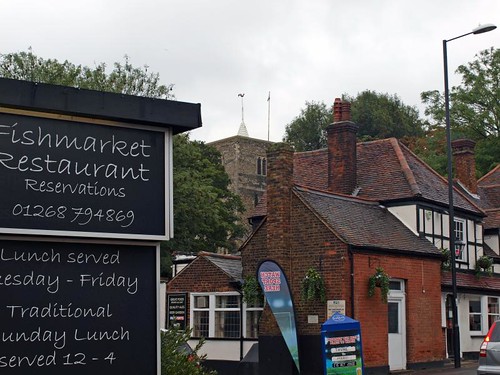ST MARY. A biggish church, as churches in this part of the county go. Big W tower with angle buttresses at the foot, and a recessed spire. The original windows indicate an early C14 date. Nave with Perp clerestory, S and N aisles, both Perp, but the (embattled) S aisle probably a little earlier. The chancel also is Perp. The most rewarding part of the church is the timber S porch, C15, unusually ornate, with panel tracery in the spandrels of the doorway, an embattled beam, tracery panels in the gable, cusped bargeboarding and a fine two-bay hammer-beam roof inside. On entering the church one becomes aware of the much earlier origin of the nave. The W wall has a plain Norman doorway (into the later tower) and high above two unusually large blocked Norman windows. Was a higher middle window or a circular window between them? The nave is impressive by its height. Its roof was raised in 1902. The carved stone corbels lower down tell of the earlier roof. The height of the present roof allows for two small windows above the chancel arch. As for the arcades between nave and aisles, the S arcade has octagonal piers, the later N arcade piers with four attached shafts and four hollows in the diagonals. The arches on both sides are double-chamfered. The chancel roof has tiebeams with king-posts and four-way struts. - SCREEN (1931) and WEST GALLERY by Sir Charles Nicholson - the Nicholsons were a Benfleet family. - PLATE. Cup with band of ornament and Paten, both of 1576.
SOUTH BENFLEET. There was a Roman emperor who set himself to stamp out Christianity. Here is the consecration cross of an English church made from Roman tiles. The cross is in the 14th century tower, capped by a shingle spire in which still rings a 15th century bell. By the chancel doorway is a medieval sundial.
It is the church porch that speaks first of beauty here; artists come from far and near to paint it, and architects to study its perfect symmetry. It was built about 500 years ago with its moulded and embattled timbers and its hammerbeams, an amazing mass of carved wood crowded into a tiny space with no suggestion of confusion. The porch has been described as a little miracle of perfection without and within. Indoors the church is handsome with a lofty nave, a modern screen painted with saints, and an organ loft adorned with prints of Fra Angelico’s angel choir.
Its oldest part is in the inner wall of the tower, which is pierced by a Norman doorway between two stopped-up Norman windows. The lofty nave has clerestory windows below which are corbels carved 500 years ago, a cat and a pig among them. There is a window and a brass in memory of the village’s great hero, vicar during an epidemic of cholera in the middle of last century. He was John Aubone Cook. Dauntless and unflinching in his devotion to his flock, in the end he sacrificed his life to them. The face of the Good Samaritan in his memorial window is thought to be a portrait.
The village lies by a creek of Hadleigh Ray separating it from Canvey Island. Here came the Danes in 893 and set up a fortified camp from which to harry the land. Alfred’s men, too much for them, seized their camp and took off to London all the ships they did not burn, and the story of this, told in the Anglo-Saxon Chronicle, has been borne out by the finding of skeletons and charred timbers when the railway was being made. There are old inns of much charm and a few old cottages, and it is a pleasant path in the shade of sycamores that brings us to the ancient tower.
It is the church porch that speaks first of beauty here; artists come from far and near to paint it, and architects to study its perfect symmetry. It was built about 500 years ago with its moulded and embattled timbers and its hammerbeams, an amazing mass of carved wood crowded into a tiny space with no suggestion of confusion. The porch has been described as a little miracle of perfection without and within. Indoors the church is handsome with a lofty nave, a modern screen painted with saints, and an organ loft adorned with prints of Fra Angelico’s angel choir.
Its oldest part is in the inner wall of the tower, which is pierced by a Norman doorway between two stopped-up Norman windows. The lofty nave has clerestory windows below which are corbels carved 500 years ago, a cat and a pig among them. There is a window and a brass in memory of the village’s great hero, vicar during an epidemic of cholera in the middle of last century. He was John Aubone Cook. Dauntless and unflinching in his devotion to his flock, in the end he sacrificed his life to them. The face of the Good Samaritan in his memorial window is thought to be a portrait.
The village lies by a creek of Hadleigh Ray separating it from Canvey Island. Here came the Danes in 893 and set up a fortified camp from which to harry the land. Alfred’s men, too much for them, seized their camp and took off to London all the ships they did not burn, and the story of this, told in the Anglo-Saxon Chronicle, has been borne out by the finding of skeletons and charred timbers when the railway was being made. There are old inns of much charm and a few old cottages, and it is a pleasant path in the shade of sycamores that brings us to the ancient tower.


No comments:
Post a Comment